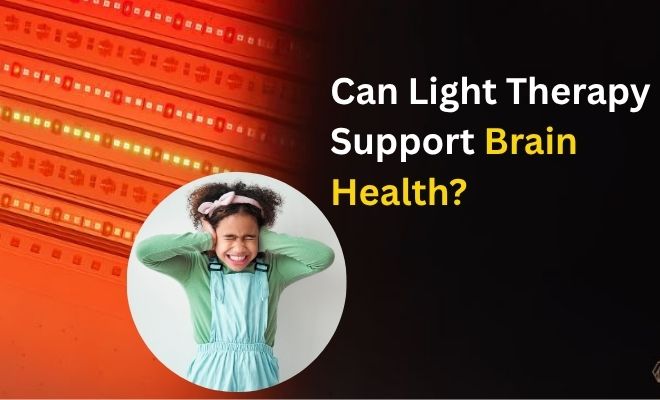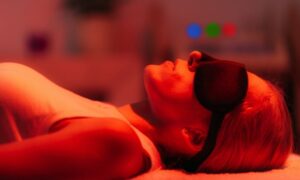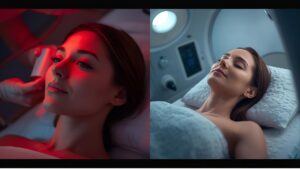Autism Spectrum Disorder (ASD) is a complex condition that impacts how individuals communicate, behave, and process sensory information. According to the CDC’s 2023 data, about 1 in 36 children in the United States are diagnosed with autism. The symptoms and challenges of ASD vary from person to person, making treatment complex. Traditional approaches mainly focus on managing symptoms like social difficulties or repetitive behaviors. However, these methods often do not address deeper biological factors, such as brain energy imbalances or chronic inflammation.
Photobiomodulation (PBM) therapy, a gentle and non-invasive light-based treatment, is gaining attention as a potential support for autism. PBM works by improving cellular energy and brain function, which may help address some of the root causes linked to ASD. In this article, we’ll explain how PBM works, explore its possible benefits for autism, review the latest research, and discuss important safety tips so families can make informed choices.
What Is Photobiomodulation (PBM)?
Photobiomodulation (PBM) is a gentle, non-invasive therapy that uses low-power red light (around 620–660 nm) and near-infrared light (about 810–1064 nm) to stimulate body tissues. Instead of heating or damaging cells, PBM delivers energy at safe power levels using LEDs or low-level lasers.
For brain health, PBM can be applied through the scalp, called transcranial PBM, to target areas of the brain, or systemically through full-body panels, intranasal devices, or blood-rich areas of the body. The goal is to activate beneficial biological signals that circulate throughout the body.
Why PBM Is Being Studied in Autism
Photobiomodulation (PBM) is being studied in autism spectrum disorder due to its ability to modulate biological processes that are often disrupted in ASD. These include mitochondrial dysfunction, neuroinflammation, oxidative stress, cerebral blood flow regulation, and neuroplasticity. Since these factors contribute to ASD pathophysiology in at least some individuals, PBM is investigated as a non-invasive, safe therapeutic approach that could complement existing behavioral and medical interventions.
Preliminary human trials have shown improvements in behavioral symptoms and brain electrophysiology, supporting further exploration of PBM as a potential treatment adjunct in autism.
How PBM Helps in Autism
Below are the leading biologically plausible pathways, supported by varying levels of evidence, through which PBM could support neurodevelopmental health in ASD.
1. Improves Mitochondrial Function
By acting on cytochrome c oxidase and related mitochondrial pathways, PBM can raise ATP production and improve cellular energy availability. Neurons are energy‑hungry; improved energy status may support synaptic signaling, dendritic remodeling, and learning functions relevant to ASD. Given the high prevalence of mitochondrial abnormalities in ASD, this mechanism is a central research focus.
2. Reduces Neuroinflammation
Experimental PBM studies show downregulation of pro‑inflammatory cytokines such as IL‑6 and TNF‑α and modulation of microglial activity. Because elevated inflammatory markers correlate with irritability, sleep problems, and cognitive or behavioral challenges in many ASD cohorts, anti‑inflammatory effects are of particular interest.
3. Enhances Cerebral Blood Flow & Oxygenation
Light‑induced nitric oxide release and vascular effects can improve regional blood flow and oxygen delivery. Neuroimaging and near‑infrared spectroscopy (NIRS) work in PBM research shows increases in cerebral oxygenation; animal stroke models using 1064‑nm light demonstrate improved perfusion and endothelial signaling. Better blood flow may support attention, mood regulation, and processing speed—areas where some individuals with ASD struggle.
4. Promotes Neuroplasticity
PBM has been shown to increase expression of brain‑derived neurotrophic factor (BDNF) and other growth and synaptic markers in animal and human studies exploring cognitive decline, traumatic brain injury, and other neurological conditions. Because BDNF supports learning and adaptive behavior, PBM‑driven neurotrophic signaling could help reinforce therapeutic gains from behavioral interventions in ASD.
5. Balances Brain Networks
Functional brain studies suggest PBM can modulate network oscillations and activity within large‑scale brain networks (e.g., default mode network, frontal midline circuits). ASD is frequently associated with atypical default mode network connectivity and sensory network imbalance; normalizing these patterns may translate to improvements in social responsiveness and sensory regulation, though this remains to be rigorously tested.
Research Evidence: PBM for Autism
Research is still early, and study designs vary widely. Here is what we know so far across model systems and human data.
Animal Studies
Mouse models displaying autism‑like behaviors have shown reductions in anxiety‑like behavior, improvements in social interactions, and modulation of inflammatory and mitochondrial markers after brain‑directed PBM. While animal data cannot be assumed to translate directly to humans, these studies help map plausible mechanisms and guide dosing for early human work.
(Source)
Notable Studies in Children
Recent clinical research in the United States is showing promising results for photobiomodulation (PBM) in children with autism spectrum disorder (ASD). In one open-label study, 23 children between the ages of 2 and 7 received near-infrared light therapy (850 nm, 40 Hz) twice a week for 10 weeks. The treatment targeted key brain regions and led to an average 7-point improvement on the Childhood Autism Rating Scale (CARS-2). Researchers also observed positive changes in brainwave activity, with no moderate or severe side effects reported.
Another randomized, sham-controlled study with 30 children aged 2 to 6 supported these findings. Children in the active PBM group experienced a significantly greater reduction in CARS scores compared to the control group. EEG scans also revealed improved neural connectivity, suggesting better brain function. Importantly, no serious adverse effects were reported, further confirming PBM’s safety for children with ASD.
Clinical Trials
A randomized, sham‑controlled pediatric study of transcranial PBM reported statistically significant improvements on autism rating scales and EEG measures relative to sham, with good tolerability. Additional controlled trials are underway (e.g., NCT05363982; NCT04660552) to evaluate efficacy, dosing, and safety in broader age ranges and symptom profiles. Early work also explores sleep quality, irritability, and attention as measurable outcomes. Larger, multi‑site randomized controlled trials (RCTs) are needed to confirm benefits, identify responders, and standardize protocols.
PBM Protocols for Autism (Experimental & Investigational)
Important: The protocols below reflect what has been used in research settings; they are not formal treatment recommendations. Always work with a qualified healthcare professional experienced in pediatric neuromodulation before trying PBM for ASD.
1. Transcranial PBM (tPBM)
- Target areas: Frontal cortex and sometimes temporoparietal regions involved in social communication and executive function.
- Wavelengths: NIR light in the 810–1064 nm range is commonly used because it penetrates deeper through the scalp and skull to the cortical tissue.
- Session length: Many pilot and early clinical studies use 10–20 minute sessions per site or montage.
- Frequency: 2–3 sessions per week over 4–8 weeks is typical in published pediatric research; some protocols taper or move to maintenance.
- Delivery systems: Helmet or cap arrays, hand‑held emitters positioned over standardized scalp landmarks, or wearable LED headbands programmed for pulse parameters.
Practical Tips (if overseen by a clinician):
- Start low: Use lower irradiance and fewer sites during an initial tolerance phase, especially for sensory‑sensitive children.
- Track behavior: Have caregivers log sleep, mood, attention span, and any agitation after each session to guide dosing adjustments.
- Combine with therapy: Schedule PBM sessions before speech or behavioral therapy blocks to explore whether improved alertness or regulation enhances participation.
Safety and Precautions
PBM is considered low‑risk, non‑invasive, and generally well tolerated in pediatric and adult neurological applications, with no serious adverse events reported in the ASD studies to date; transient, mild effects (e.g., temporary hyperactivity, headache) resolved without intervention.
Follow these safeguards:
- Respect dose guidelines. More light is not always better; excessive energy density can diminish benefits or cause temporary symptom flare‑ups. Use manufacturer‑ or clinician‑guided parameters that align with published ranges.
- Protect the eyes during cranial sessions. Pediatric participants in research settings typically wore protective eyewear or kept their eyes closed with shielding when light sources were near the face.
- Use medical‑grade, clinically validated devices. Devices designed for brain PBM include calibrated output, known beam profiles, and safety interlocks important for repeatable dosing across sessions.
- Coordinate with your healthcare team. Children receiving multiple therapies (behavioral, educational, nutritional, metabolic) benefit when PBM plans are shared, so everyone watches the same outcome measures.
Enhance Brain and Body Wellness with HueLight’s Whole Body PBM Chamber
If you’re curious about how to integrate photobiomodulation (PBM) into autism care, Huelight offers an innovative, clinically-informed approach that brings this emerging technology to your home or clinical setting.
Backed by evidence and designed for ease of use, Huelight’s PBM device makes it simple to explore the potential neurodevelopmental benefits of red and near-infrared light therapy, whether you’re supporting a child, teen, or adult on the autism spectrum.
HueLight’s PBM Chamber is trusted by leading hospitals and clinics, FDA-cleared, and built to meet the highest safety standards, making it ideal for families looking for drug-free, holistic approaches to wellness.
Want to Learn More?
Call us at (+82)2-898-2116 or contact our team today to discover how the HueLight Whole Body PBM Chamber can help support your child’s neurodevelopmental health journey.













